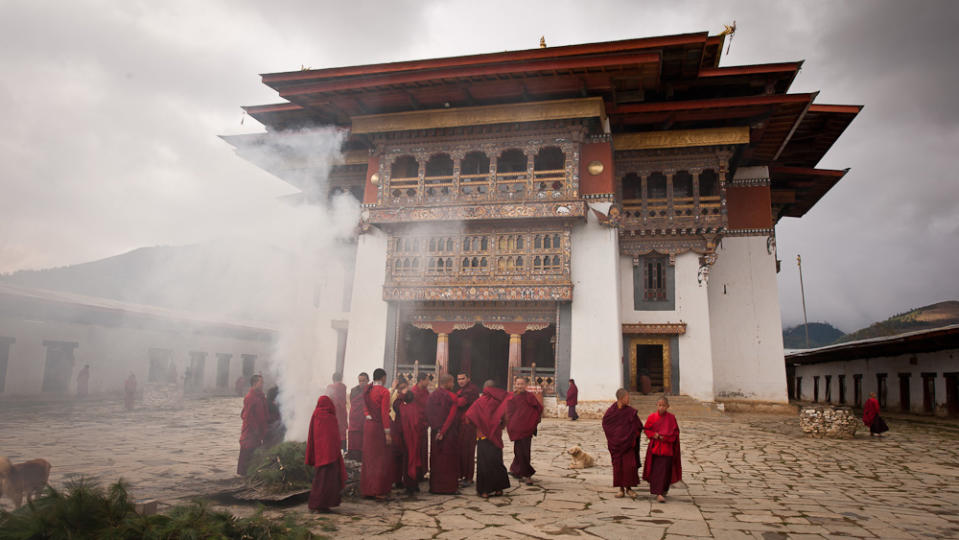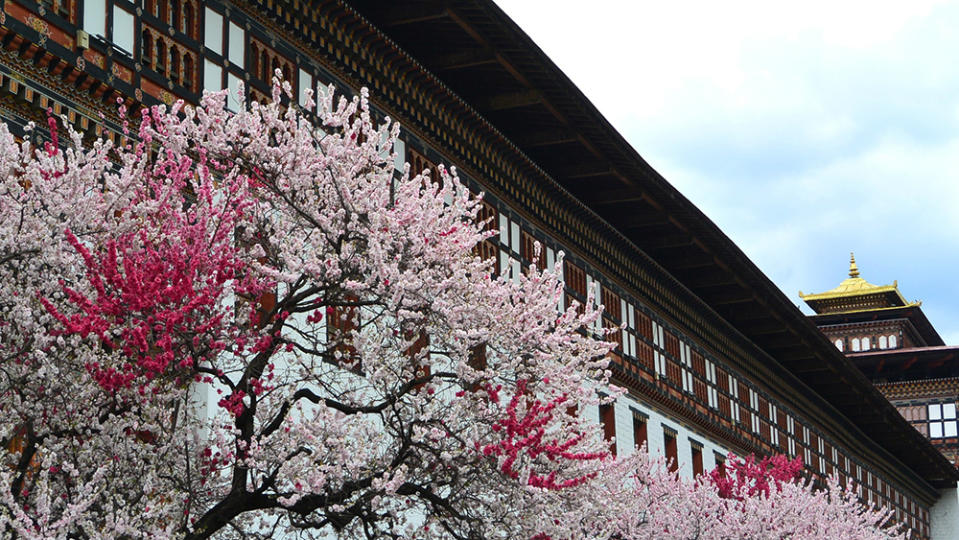How the Small Nation of Bhutan Became an Exclusive Destination for Travelers

Roughly half the size of Indiana, Bhutan is defined by landscapes of emerald green fir trees, patchwork quilts of farmland, and endless switchback roads. It’s a place where powdered sugar mountain peaks evoke mysticism, where a clap of thunder is an omen from the dragons, and televisions were introduced just before the new millennia. An incredible 71 percent of the nation is covered with trees.
Enchantingly beautiful, this remote Himalayan kingdom is known for gravity-defying cliffside temples and for measuring GNH (Gross National Happiness) over GDP. More recently, it’s become just as well known for its environmental efforts and its claim to fame as the world’s first carbon-negative country.
More from Robb Report
Six Senses Is Opening a New Luxury Resort in Grenada. Here's a Look Inside.
New Luxe Hotels Are Reshaping Rome's Hospitality Scene. Here's How.
How Hong Kong's Finest Hotels Are Luring Travelers Back to the City
It was also synonymous with backpackers—mostly of the crunchy granola, short-on-cash variety.

But as Bhutan enters into its 50th year of tourism—first inking passports in 1974 for 300 trekkers and spiritual seekers—it’s trying re-branding itself as a luxury destination. And in its quest for exclusivity, it’s hitting people right in the pocketbook.
When the country reopened from Covid-19 lockdowns in September 2022, the government implemented a controversial $200 per person per day Sustainable Development Fee (SDF). This new daily fee made Bhutan a bonafide pipedream for backpackers and budget-friendly travelers worldwide. Many local tour guides and hospitality owners also expressed concerns that the fee would effect their bottom line.
It was a bust, and on Sept. 1 Bhutan cut that fee in half for travelers paying in U.S. dollars until 2027. Children aged six to 12 get a further 50 percent discount.
“Bhutan has always had an SDF,” says Dorji Dhradhul, Director General of the Department of Tourism for Bhutan. “For many, many years, that fee was $65. We felt it was the right time to reinforce Bhutan’s focus on high-value, low-volume tourism.”
A $100-a-day fee for U.S. travelers is still nothing to scoff at, and it is changing the nation’s tourism landscape. Luxury lodges are now the name of the game here, with more than a dozen and counting to choose from.

Brands such as Six Senses and Aman have beautifully bespoke fireplace-filled lodges in each of the country’s major tourist hot spots: Paro, Thimphu, Punakha, Gangtey, and Bumthang. Como operates lodges that resemble the country’s stately dzongs (former fortresses turned into administration offices and temples) in Paro and Punakha. And this fall, andBeyond’s Punakha River Lodge will be added to the Rolodex.
In Gangtey Valley, where the black neck cranes draw naturalists from around the world from October to February, the independently owned Gangtey Lodge is one of the country’s most exceptional. A cathedral-ceiling main lodge is hand-painted with scenes from the valley and flanked by two stone fireplaces. Inside each of its 12 rooms, the coziness continues with heated floors, potbelly stoves, and soaking tubs with valley views.
At lodges like these, general managers are starting to notice the shift. In a place as spiritual as Bhutan—where 75 to 80 percent of its less than 800,000-person population are Mahayana Buddhist—meditation and temple visits were the main reason for visitors. But now, the outdoors addicts are arriving.

Besides the brochure-famous trek to the Tiger’s Nest, there are endless world-class hiking opportunities around the country, and the lodges are pairing them with finer things. At Gangtey Lodge, guests can zig-zag to the top of a mountain where 360-degree views and a three-course lunch will be waiting. And at Six Senses Thimphu, a hike to Nimnub Point is rewarded with your favorite cocktail and canapes as the sun sets over the mountain ranges.
“Bhutan’s approach to tourism means no crowds, no queues, very little consumerism and the chance to immerse oneself in an authentic culture steeped in tradition,” says Andrew Whiffen, Six Senses Bhutan’s general manager. “Luxury travel has evolved to become more about experiences, discovery, and meaningful connections. Bhutan offers this in spades.”
The Lowdown

Getting There
As per law, only Bhutanese pilots can land in between the mountains at Paro International Airport, so Royal Bhutan Airlines, a.k.a. DrukAir, and Bhutan Airlines are the country’s two carriers. Connections through major hubs such as Bangkok, Singapore, and Delhi are just part of the arrival adventure.
Getting Around
Roads here can be downright treacherous (remember to pack motion sickness meds), so a private driver is a must and can be arranged with a tour operator, travel agent, or your lodge.
Operators
While no longer required, group and private tours are the norm in Bhutan, and there are loads of top-notch operators to choose from. Remote Lands, Scott Dunn, and Artisans of Leisure can all arrange dream itineraries here. And with nature a top priority for most, book in the spring (March through May) and fall (September to November).
Best of Robb Report
The Ultimate Miami Spa Guide: 15 Luxurious Places to Treat Yourself
The 7 Most Insanely Luxurious Spas in the World, From Tokyo to Iceland
17 Reasons the Caribbean Should Be at the Top of Your Travel Itinerary
Sign up for Robb Report's Newsletter. For the latest news, follow us on Facebook, Twitter, and Instagram.


